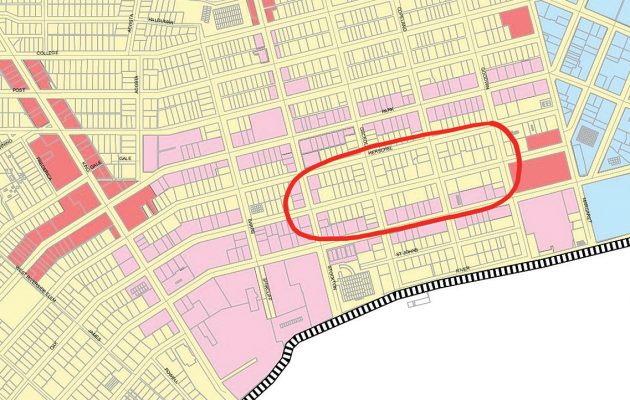Amendments to Riverside Avondale Zoning Overlay underway
Posted on September 3, 2016 By Editor Articles, Neighborhood News, Top Stories

While some residents of Riverside and Avondale wait for legislation to help curtail retail and commercial development in the historic district, attorneys for restaurateurs are busy filing applications, administrative deviations and waivers, which will “grandfather” their projects against any new regulations.
For almost three months, District 14 Councilman Jim Love’s bill to amend the Riverside Avondale Overlay has been undergoing dissection and re-assembly by the City of Jacksonville’s Planning and Development Department, the Office of the General Counsel, and Councilman Love.
Love initially introduced Bill 2016-366 to the City Council May 24 with the intent to amend the Overlay to prevent negative consequences from development or re-development within Historic Residential Character Areas (HRCA), defined as areas that are not contained within the commercial, office, urban transition or industrial character areas. In short, neighborhoods such as the one along the Oak Street corridor south of 5 Points.
After 12 weeks of slicing and dicing, Bill 2016-580 was introduced Aug. 23 to City Council. “It was recommended by the Office of General Counsel that it would be cleaner to introduce a new bill,” said Love in an email.
Essentially, what was removed from Love’s new bill is the requirement for Planned Unit Developments to be constructed on at least two acres of land and to contain a residential component. The PUD proposed for The Roost restaurant on Oak Street, which in part drove this measure to amend the Overlay, does not contain a residential portion and the size of the property is 0.75 acres. Instead, the bill will not permit rezoning for a property if its intended use will create intensity – traffic, noise, lights, etc. – around surrounding properties.
Determining intensification, however, will not be an easy task. Applicants with new developments, such as the proposal to raze St. Johns Village for new apartments, would most likely include traffic studies and usage projections in their applications, leaving the final decision about intensification squarely in the laps of those on the three quasi-judicial entities: the Planning Commission, the Land Use and Zoning Committee, and the City Council.
This bill will also require the Council to evaluate specific criteria before approving a land use or zoning application in the Riverside/Avondale Overlay, as well as limiting deviations and waivers, providing parking requirements, and providing standards for restaurants in the HRCA.
One section in the bill addresses identification of Character Areas, adding Five Points Village as a predominantly commercial area, and changing the boundary of the Oak Street Character Area, which is predominantly zoned for office, from Barrs to Stockton Street. The block south of Stockton to Barrs Street is mostly commercial between Herschel Street and Riverside Avenue, supporting businesses in food, healthcare and general services.
Preserving quality of life
Of note, in the bill are three items which address recurring issues in the historic districts, particularly due to restaurant growth in Riverside and Avondale over the past four years.
The first would limit deviations and waivers applied for on behalf of commercial or retail development within the HRCA. The proposed bill states, “In no instance shall deviations or waivers be granted in an amount in excess of 20 percent as required by the Zoning Code for parking, signage, seating, and hours of operations.”
Sondra Fetner, Office of General Counsel, confirmed the verbiage applies as much to “more” as it does to “less.” For example, a restaurant applying for the 60-seat maximum may request a deviation to put in 72 seats – 20 percent more than the stated maximum; conversely, if 20 parking spaces are required, the restaurant may get a waiver to supply 16, or 20 percent less than needed.
The second item, which provides for parking design standards and requirements within the HRCA, addresses the Overlay’s current allowance for zero parking when new structures are built to the same or less square footage of a non-conforming structure being replaced. The bill will remove that allowance and, further, would require on-site parking.
That portion of the bill includes other parking standards, stating no shared parking agreements will be considered for determining compliance with the parking requirements; all on-site parking for all uses shall be stabilized and of a pervious nature, except for the driveway and required ADA accessible spaces; conversions of contributing structures from non-residential to residential use may provide 50 percent of the required number of parking spaces, while conversions from residential to non-residential shall provide 100 percent; and parking in front yards or between the street edge and sidewalk/property line is prohibited.
Finally, in order to protect residents’ quality of life, the bill would provide standards for restaurants in the HRCA, essentially limiting hours of operation, seating capacity, and outdoor activity.
The bill, as introduced, states that while not permitted in any residential zoning districts, restaurants in other zoning districts are subject to restrictions. Only existing structures with a non-residential original use shall be permitted to operate as a restaurant, open to the public from 8 a.m. to 8 p.m., with overall operating hours of 7 a.m. to 10 p.m. All parking shall be provided for on-site, and the restaurant shall control the effects of lights from automobiles or other sources. Seating shall not exceed a capacity of 60; service is on premises only; drive-thru restaurants are prohibited; there shall be no amplified live music, and no entertainment, waiting areas or service of food or alcohol outside the restaurant.
While Bill 2016-366 was under the knife, several restaurant applications have been filed for Riverside/Avondale. However, any applications for restaurants – such as the one proposed for the space formerly occupied by Cowford Traders in the Shoppes of Avondale – introduced prior to the effective date of this bill would not fall under the restrictions of Bill 2016-580.
By Kate A. Hallock
Resident Community News




 (No Ratings Yet)
(No Ratings Yet)




